Bird Watching in our Neighborhood Aurora II
BIRD WATCHING IN OUR NEIGHBORHOOD AURORA II
GUATEMALA CITY BIRDS
By Lorena Bleker
With the help from a guest that is a professional birdwatcher and biologist from Sweden, we have made a list of some of the birds that you can find, observe and enjoy in our small neighborhood Aurora II.
The observation was made in the months of February and March, but many of these birds can be appreciated most of the year and some others start to immigrate from the north around august or later…
Despite the severe biodiversity loss due to airport, massive urbanization, pollution, invasive species, habitat loss and climate change, we still enjoy of some beautiful birds in our area. We would like to help to re-connect our guests and neighbors with the natural world and raise awareness of the seriousness that biodiversity loss represents and how it affects them directly and to all of us.
For those who are birdwatchers, if you are visiting our neighborhood, and you identify another type of bird that is not on the list, please let us know and send us details so we can add it to this list. hoteldoslunas@gmail.com
GARDEN AND RAVINE BIRDS
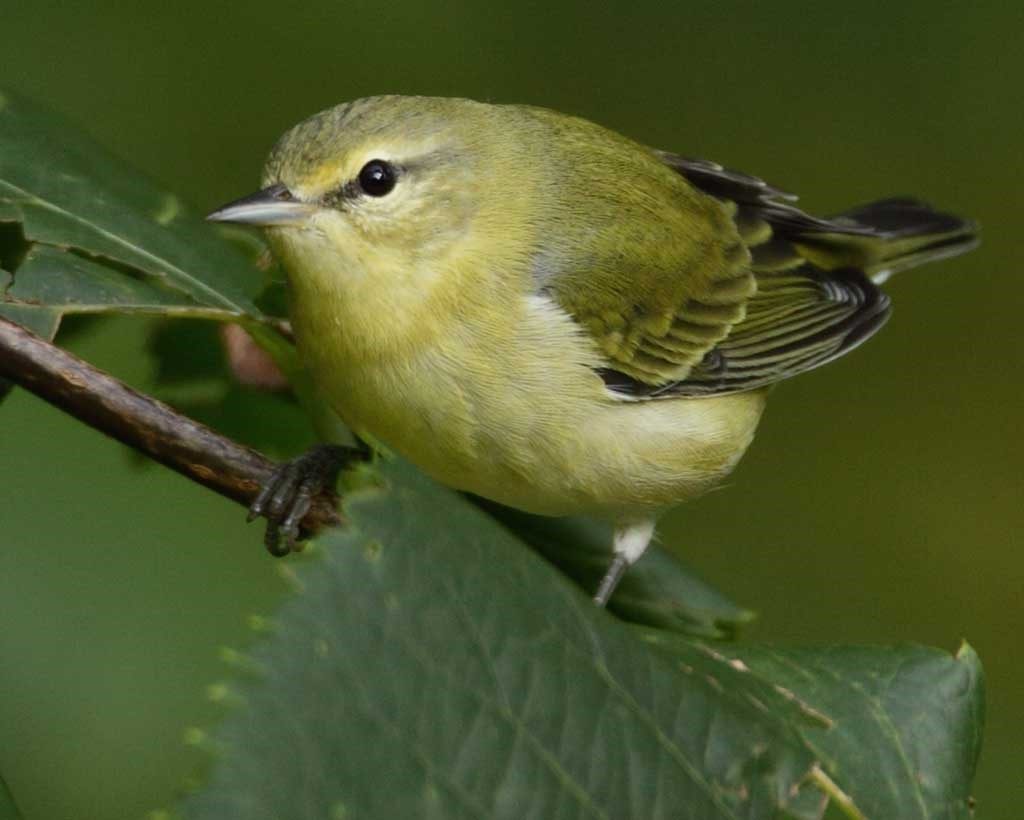
Photo By National Audubon Society www.audubon.org
Name: TENESSEE WARBLER (M)
Scientific Name: Oreotriplys Peregrina
Name in Spanish: Chipe Peregrino
Description:
The Tennessee Warblers loud, staccato song often signals the peak of spring songbird migration in eastern North America. Described by Alexander Wilson in 1811 from a migrant specimen on the banks of Tennessee’s Cumberland River, its common name belies the fact that its breeding range is restricted almost entirely to the boreal forest zone of Canada, extending into southeastern Alaska and the extreme northern fringe of the United States. Most migrants move along the eastern seaboard east of the Mississippi Valley, crossing the Gulf of Mexico to and from wintering grounds in Central and northern South America. *
*Tennessee Warbler (Oreothlypis peregrina), In Neotropical Birds Online (T. S. Schulenberg, Editor). Cornell Lab of Ornithology, Ithaca, NY, USA. retrieved from Neotropical Birds Online: https://neotropical.birds.cornell.edu/Species-Account/nb/species/tenwar
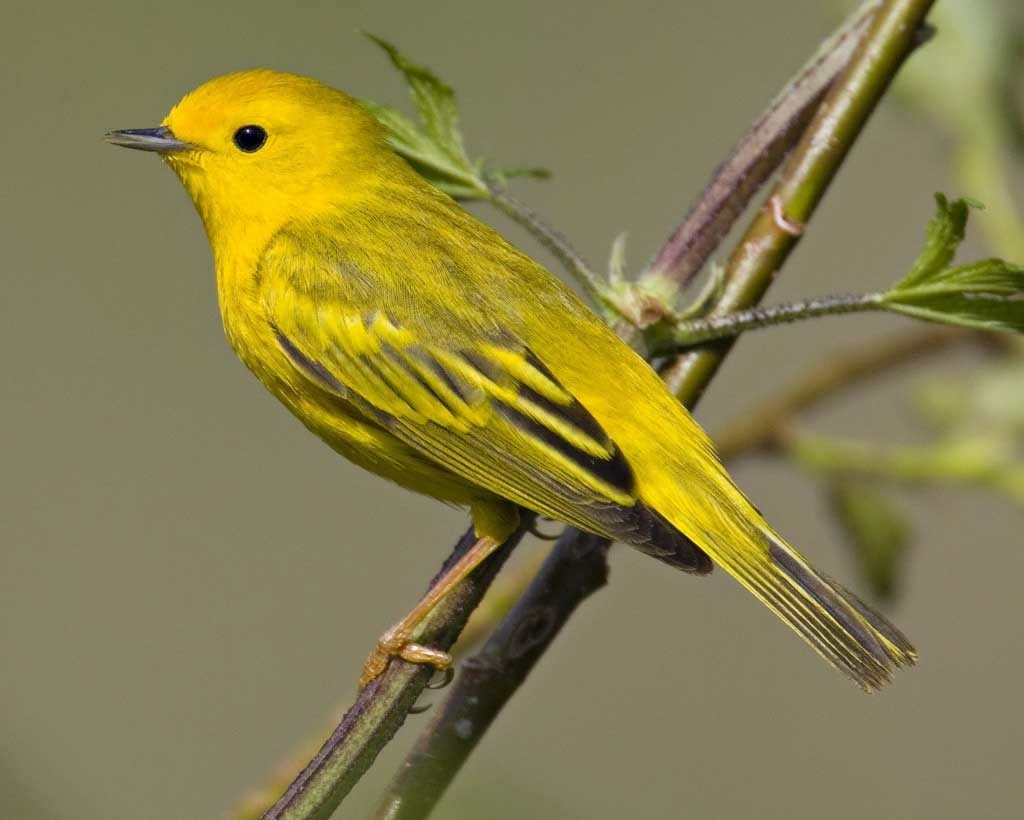
Name: YELLOW WARBLER (M)
Scientific Name: Sethopaga Petechia
Name in Spanish: Chipe amarillo
Description:
The aptly named Yellow Warbler is found throughout much of North America in habitats briefly categorized as wet, deciduous thickets. Most resident populations in the Caribbean and in Central and South America breed in mangroves, although at some sites they also occur in coastal scrub or even in montane forests. The Yellow Warbler is the most strikingly yellow among North American wood-warblers. *
This bird Migrates mostly at night. Fall migration is very early, with many moving south during August.
*Yellow Warbler (Setophaga petechia), In Neotropical Birds Online (T. S. Schulenberg, Editor). Cornell Lab of Ornithology, Ithaca, NY, USA. retrieved from Neotropical Birds Online: https://neotropical.birds.cornell.edu/Species-Account/nb/species/yelwar
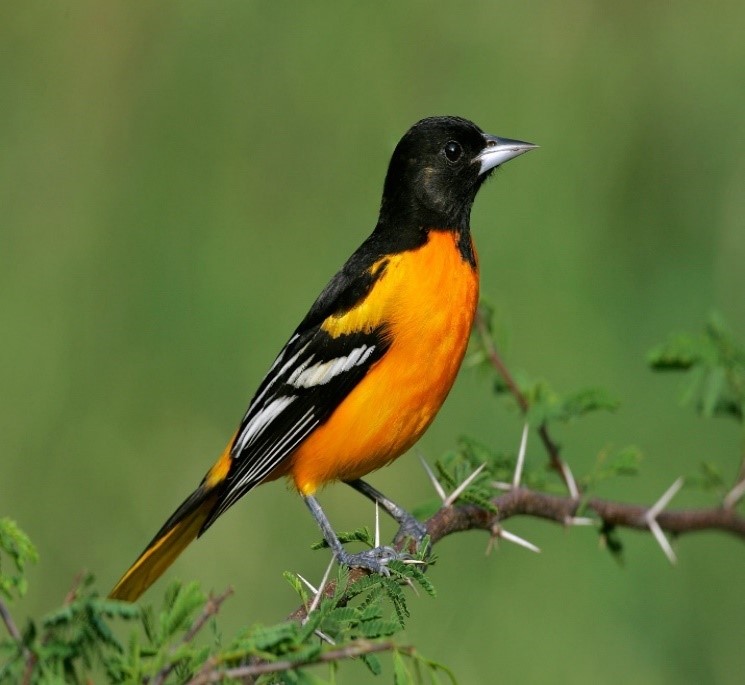
Name: ORCHARD ORIOLE (M)
Scientific name; Icterus Spurius
Name in Spanish: Bolsero castaño
Description:
Most common in the Midwest and South is this small oriole. It favors open areas with scattered groves of trees, so human activities may have helped it in some areas, opening the eastern woodlands and planting groves of trees on the prairies. Orchard Orioles often gather in flocks during migration. The black-throated young male, sitting alone in a treetop and singing his jumbled song, is often confusing to beginning birders. Migrates in flocks; many move north across the Gulf of Mexico in spring. Fall migration begins very early, with some southbound by late July.
Source: https://www.audubon.org/field-guide/bird/orchard-oriole
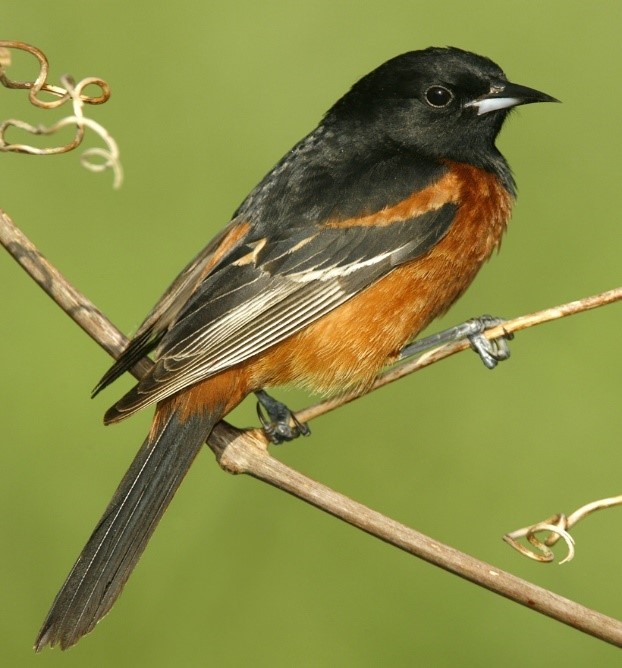
Copyright: ©Brian Small/VIREO
Name: BALTIMORE ORIOLE (M)
Scientific name: Icterus Galbula
Scientific name: Icterus Galbula
Name in Spanish: Bolsero de Baltimore
Description:
One of the most brilliantly colored songbirds in the east, flaming orange and black, sharing the heraldic colors of the coat of arms of 17th-century Lord Baltimore. Widespread east of the Great Plains, Baltimore Orioles are often very common in open woods and groves in summer
Migrates in flocks. Fall migration begins early, with many birds departing in July and August from North America to Central and South America.
Source: https://www.audubon.org/field-guide/bird/baltimore-oriole
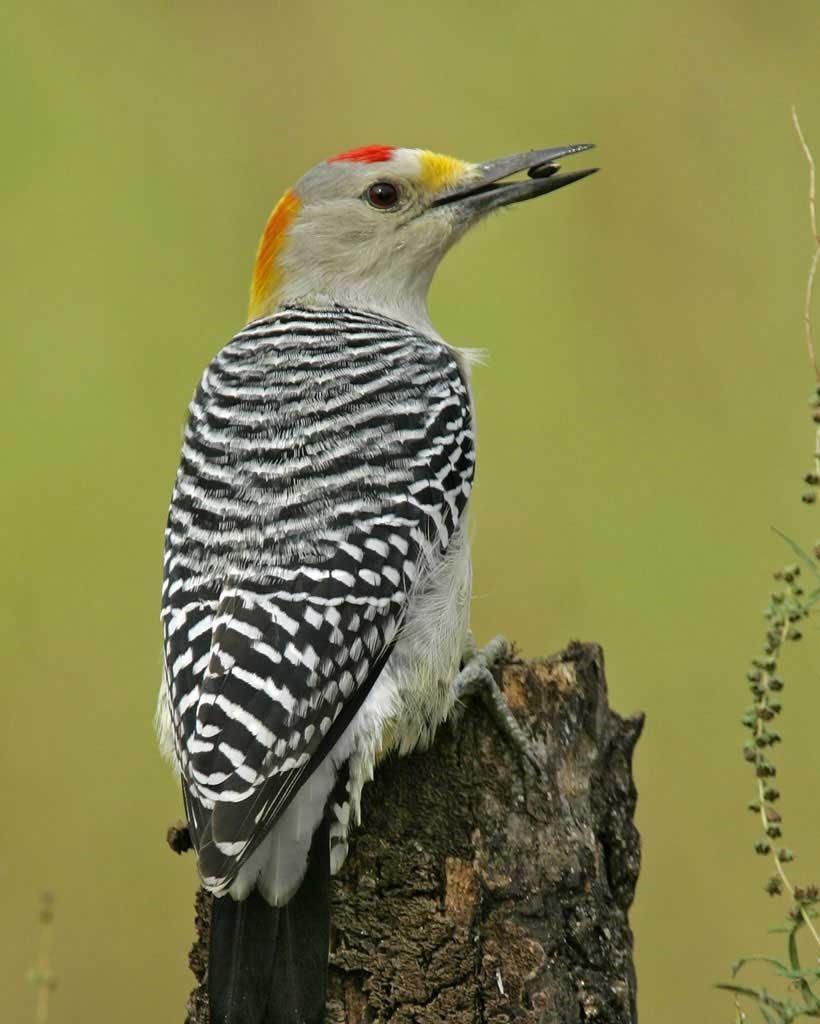
Name: GOLDEN FRONTED WOODPECKER (R)
Scientific name: Melanerpes Aurifrons
Name in Spanish: Carpintero frentidorado
Description:
A sedentary species whose distribution straddles the temperate and tropical regions of Middle America, the Golden-fronted Woodpecker ranges into the United States only to Texas and southwestern Oklahoma. *
*Golden-fronted Woodpecker (Melanerpes aurifrons), In Neotropical Birds Online (T. S. Schulenberg, Editor). Cornell Lab of Ornithology, Ithaca, NY, USA. retrieved from Neotropical Birds Online: https://neotropical.birds.cornell.edu/Species-Account/nb/species/gofwoo
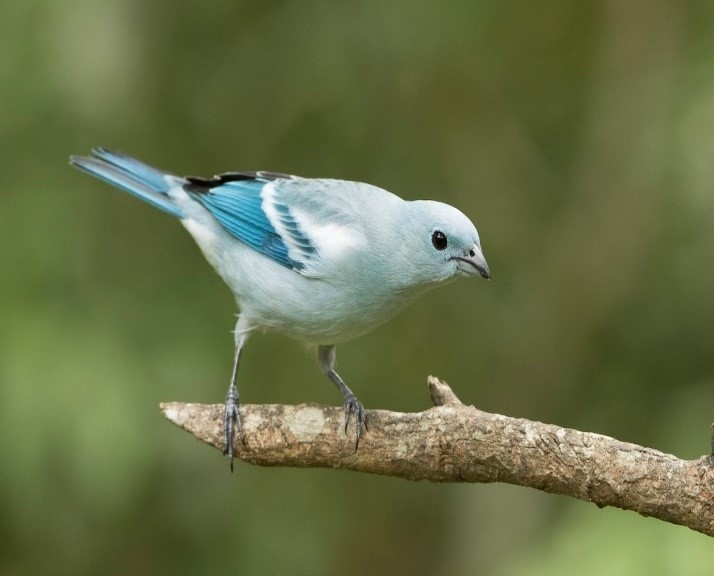
© Brian Sullivan Macaulay Library ML66383931
Name: BLUE-GRAY TANAGER (R)
Scientific Name: Thraupis Episcopus
Name in Spanish: Tángara azul-gris
Description:
The Blue-gray Tanager is one of the most widespread, and
ubiquitous, birds of the humid lowland neotropics. At almost any location
between southeastern Mexico and central South America, it is a familiar
presence at forest edge, in second-growth, along roads and rivers, in
plantations, and even in urban parks and gardens.
Blue-gray Tanager (Thraupis episcopus), In Neotropical Birds Online (T. S. Schulenberg, Editor). Cornell Lab of Ornithology, Ithaca, NY, USA. retrieved from Neotropical Birds Online: https://neotropical.birds.cornell.edu/Species-Account/nb/species/bugtan
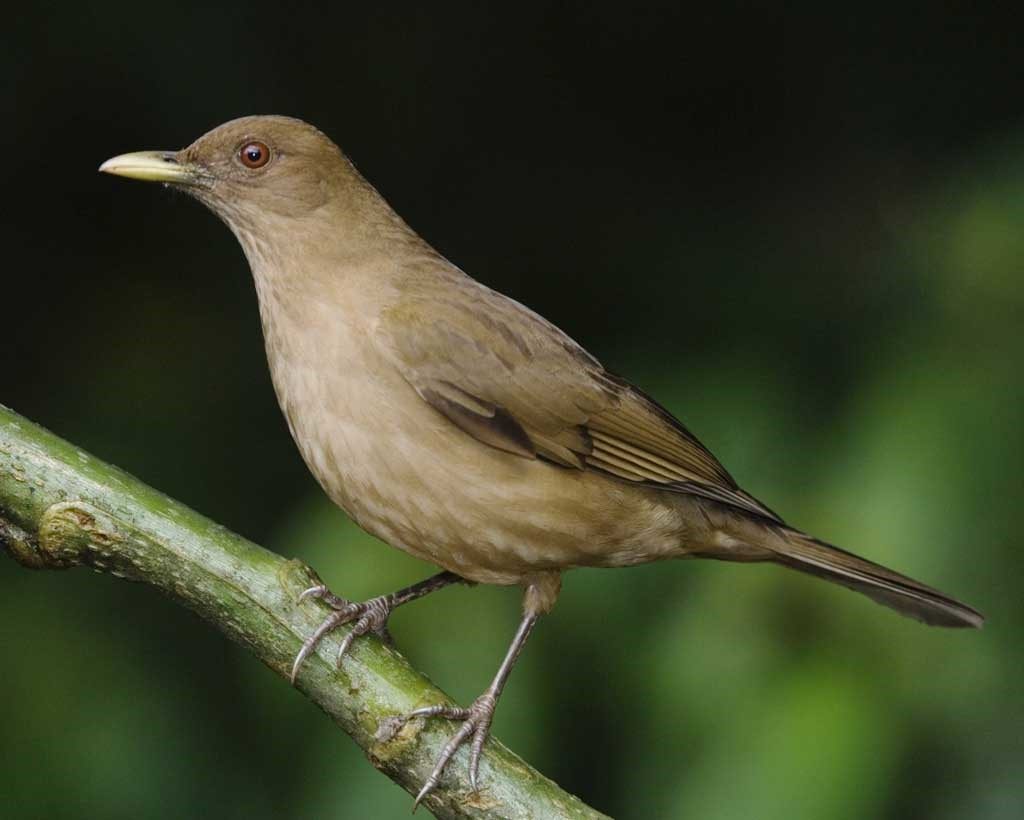
Name: CLAY COLORED THRUSH (R)
Scientific name: Turdus Grayi
Name in Spanish: Mirlo o Censontle
Description:
From eastern Mexico to northern Colombia, this plain gray-brown thrush is very common in lowland habitats, including parks and gardens. In recent years it has become a regular visitor to southernmost Texas, especially in winter, and it has even nested there several times. It was formerly called Clay-colored Robin.
Source: https://www.audubon.org/field-guide/bird/clay-colored-thrush
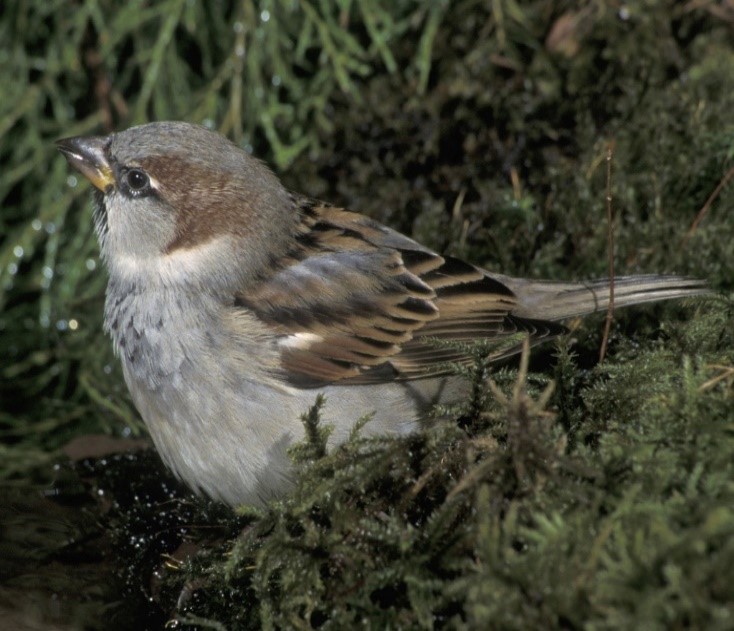
Photo By National Audubon Society www.audubon.org
Name: HOUSE SPARROW (E)
Scientific Name: Passer domesticus
Name in Spanish: Gorrion
Description:
Permanent resident over most of its range, including throughout North America. One of the most widespread and abundant songbirds in the world today. Tough, adaptable, aggressive, it survives on city sidewalks where few birds can make a living; in rural areas, it may evict native birds from their nests.
Source: https://www.audubon.org/field-guide/bird/house-sparrow
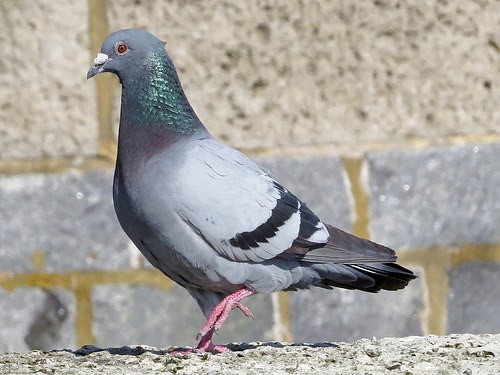
Name: FERAL PIGEON (E)
Scientific Name: Recurvirostra avosetta
Name in Spanish: Paloma
Description:
Feral pigeons are descended from the rock dove which was
originally domesticated to provide food. Feral pigeons are now found all over
the world
Rock doves have blue-grey under and upperparts and a white patch on their
rumps. There is an iridescent band of green and purple on their necks and they
have grey wings with two black wing-bars. Their eyes and legs are red.
Source and Photo: https://www.britishbirdlovers.co.uk/bird-identification/ferapigeon
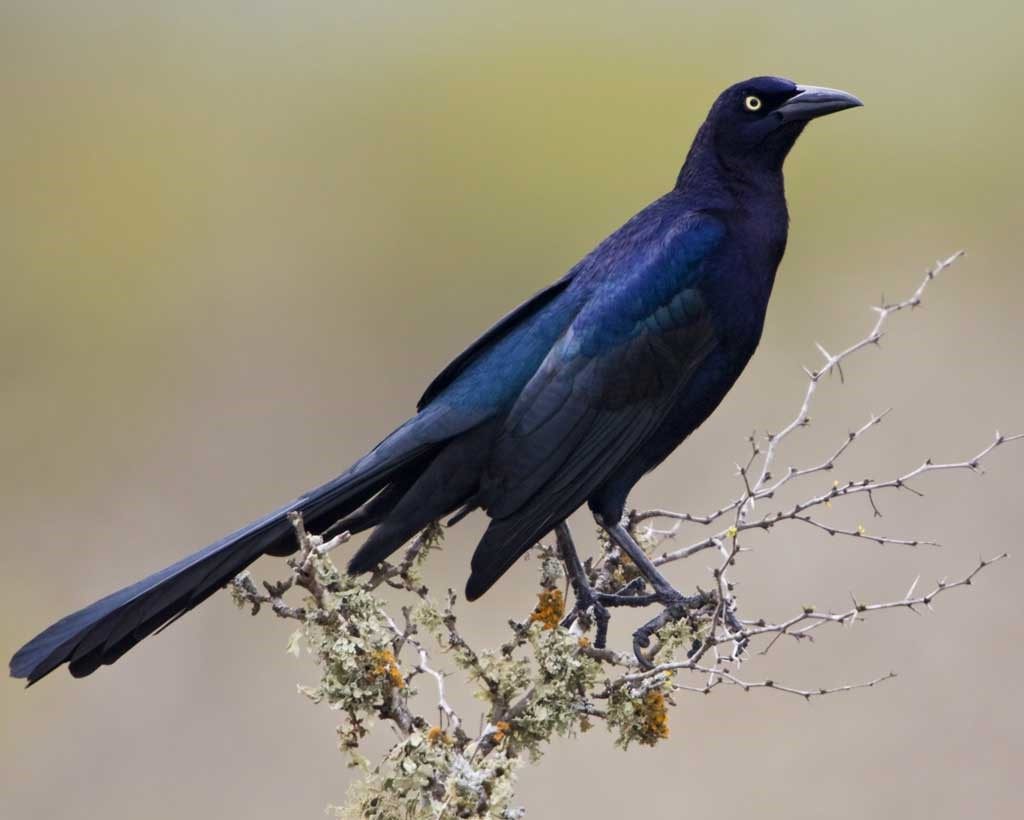
Name: GREAT-TAILED GRACKLE (R)
Scientific name: Quiscalus mexicanus
Name in Spanish: Zanate
Description: Mostly migratory in northern parts of its range; however, it has recently become a permanent resident in some areas where it formerly occurred only in summer. Wherever it occurs, this big blackbird is impossible to overlook — especially the male, with his great oversized tail and incredible variety of callnotes.
Source: https://www.audubon.org/field-guide/bird/great-tailed-grackle
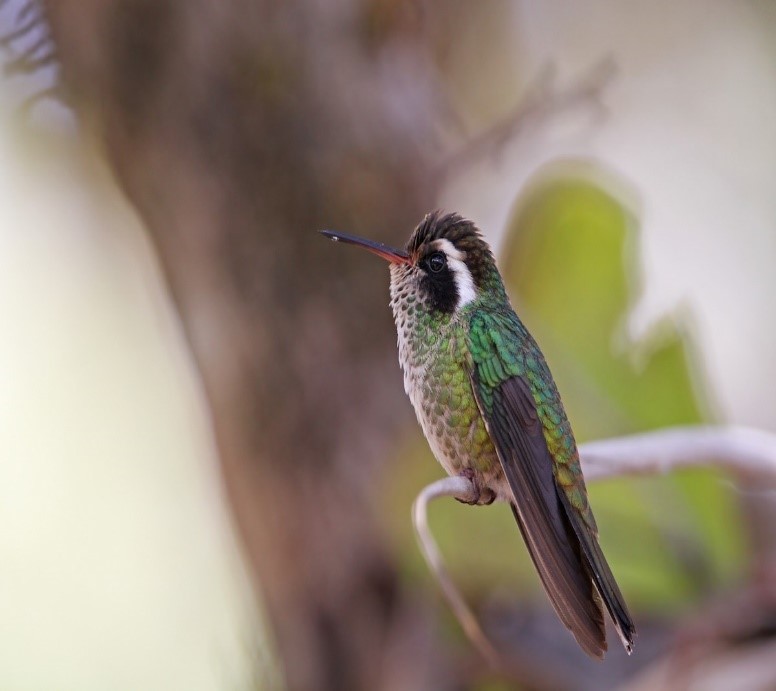
Name: WHITE-EARED HUMMINGBIRD (R)
Scientific name: Hylocharis leucotis
Name in Spanish: Colibri oregiblanco
Description:
White-eared Hummingbird occupies montane pine-oak, oak, and pine-evergreen forests from the extreme southwestern United States south to Nicaragua. These are territorial hummingbirds spend most of their time at the lower and middle levels of the forest, where they are particularly common near banks of low flowers. Both males and females have a dark cheek bordered by a long white stripe behind the eye, and both have some extent of red on the bill. Their metallic chipping song also helps identify them from similar species. *
*Arizmendi, M. d. C., C. I. Rodríguez-Flores, C. A. Soberanes-González, and T. S. Schulenberg (2015). White-eared Hummingbird (Hylocharis leucotis), version 1.0. In Neotropical Birds Online (T. S. Schulenberg, Editor). Cornell Lab of Ornithology, Ithaca, NY, USA. https://doi.org/10.2173/nb.whehum.01
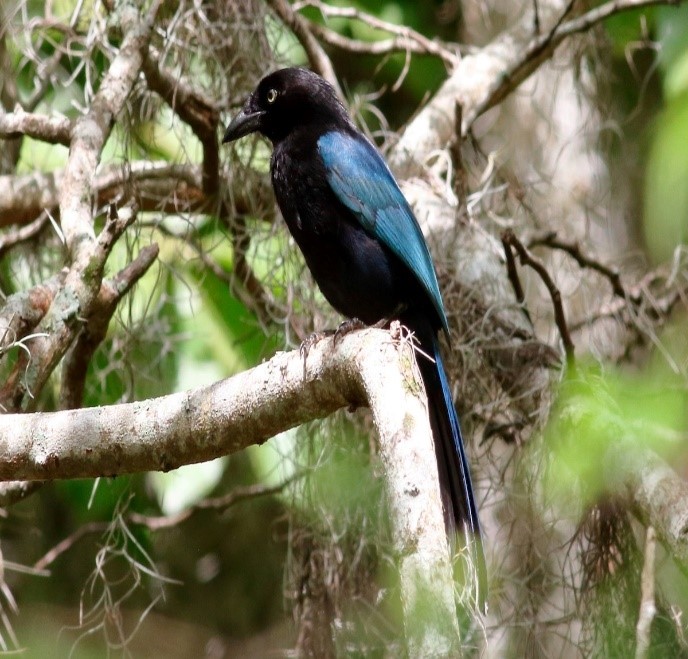
Name: BUSHY CRESTED JAY (R)
Scientific name: Cyanocorax melanocyaneus
Name in Spanish: Shara Centro Americana
Description:
The Bushy-crested Jay is one of four species of black-and-blue jays found in Central America. It is the only one of these four species with black tarsi and bluish underparts. This species lives in Guatemala, El Salvador, Honduras, and northern Nicaragua, a distribution which does not overlap with that of any of the other blue-and-black jays. This adaptable jay lives in many kinds of forests and disturbed habitats, such as coffee plantations. Bushy-crested Jays lives in family groups up to 15-20 individuals and eat insects, seeds, and fruit. The entire flock helps to rear three to six eggs in a twig nest. *
*Molfetto, D. (2010). Bushy-crested Jay (Cyanocorax melanocyaneus), version 1.0. In Neotropical Birds Online (T. S. Schulenberg, Editor). Cornell Lab of Ornithology, Ithaca, NY, USA. https://doi.org/10.2173/nb.bucjay1.01
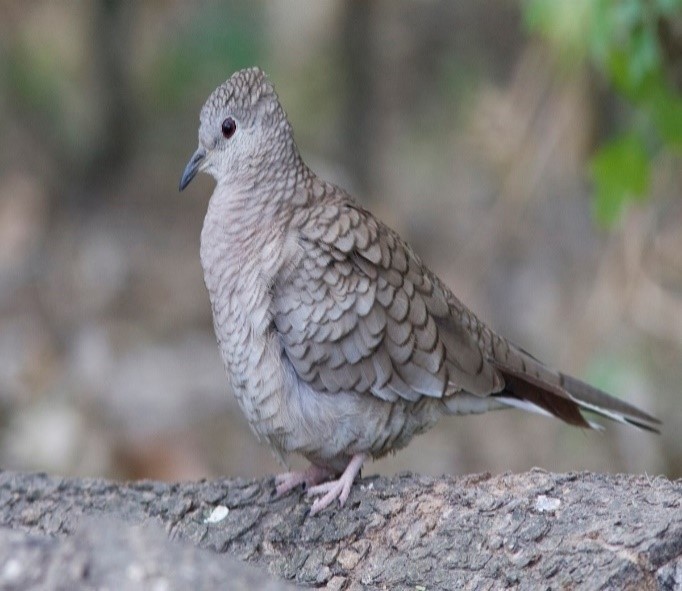
Name: INCA DOVE (R)
Scientific name: Columbina Inca
Name in Spanish: Tortolita
Description:
A small dove of Mexico, northern Central America, and the southwestern United States, the Inca Dove has extended its range both north and south over the past 100 years. A conspicuous urban resident, it commonly occurs at bird feeders and on lawns and other short grass habitats. This species was originally confined to arid habitats, and its affinity to human dwellings was attributed to the easy availability of water. It continues to spread into wetter areas, retaining its attachment to towns and cities for no obvious reason. *
* Inca Dove (Columbina inca), In Neotropical Birds Online (T. S. Schulenberg, Editor). Cornell Lab of Ornithology, Ithaca, NY, USA. retrieved from Neotropical Birds Online: https://neotropical.birds.cornell.edu/Species-Account/nb/species/incdov
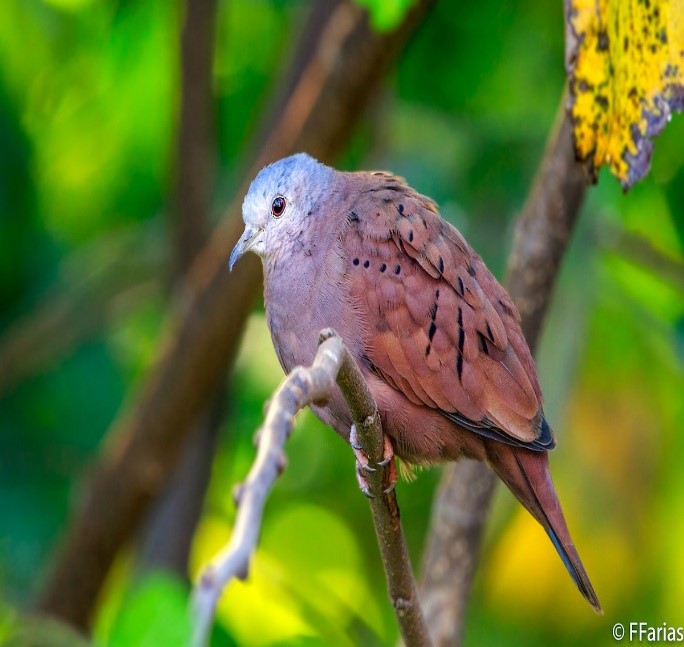
Name: RUDDY GROUND-DOVE (R)
Scientific name. Columbina Talpacoti
Name in Spanish: Columbina colorada
Description:
Ruddy Ground-Doves are appropriately named after the bright ruddy-colored plumage of the male, which makes them distinctive from males of other ground-doves. There are four subspecies ranging from northern Mexico south to eastern Peru and northern Argentina. Some geographic variation in plumage occurs with individuals in drier western areas being paler than those in wetter eastern areas. Given their flexibility in habitat use and rapid reproduction, Ruddy Ground-Doves are common throughout their range and are in the lowest threat category recognized by Bird Life International. *
*Hart, J. A. (2011). Ruddy Ground-Dove (Columbina talpacoti), version 1.0. In Neotropical Birds Online (T. S. Schulenberg, Editor). Cornell Lab of Ornithology, Ithaca, NY, USA. https://doi.org/10.2173/nb.rugdov.01
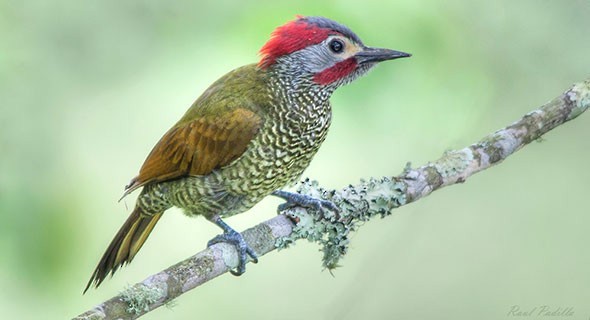
Name: GOLDEN-OLIVE WOODPECKER (R)
Scientific Name: Colaptes rubiginosus
Name in Spanish: Pájaro carpintero dorado
Description:
The Golden-olive Woodpecker is one of the most geographically widespread woodpeckers of the Neotropical region. It ranges through a wide variety of wooded habitats and over much of Middle America, from eastern Mexico just south of the US border to western Panama, and over much of highland northern and western South America. Given this broad range, it is perhaps unsurprising that some authors recognize up to 19 different subspecies. *
*Golden-olive Woodpecker (Colaptes rubiginosus), In Neotropical Birds Online (T. S. Schulenberg, Editor). Cornell Lab of Ornithology, Ithaca, NY, USA. retrieved from Neotropical Birds Online: https://neotropical.birds.cornell.edu/Species-Account/nb/species/goowoo1
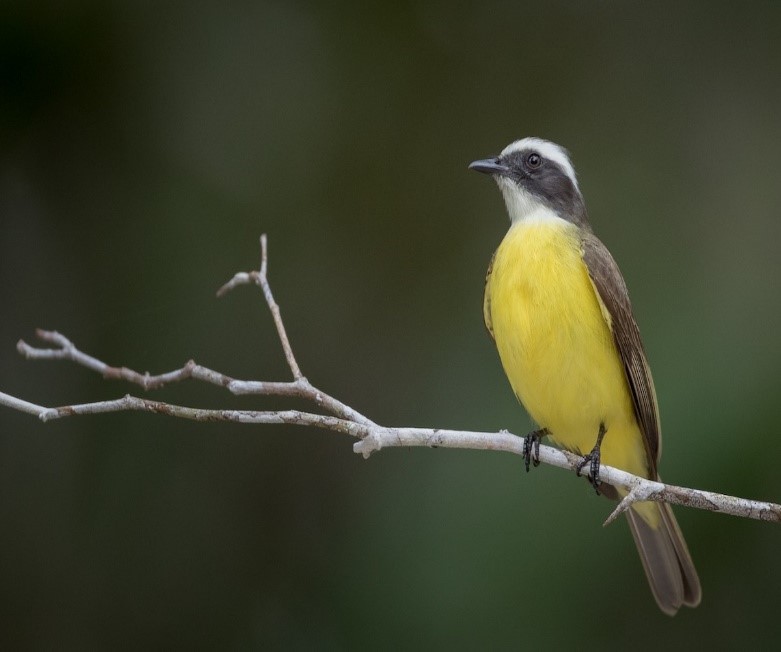
Name: SOCIAL FLYCATCHER (R)
Scientific name: Myiozetetes similis
Name in Spanish: Mosquero social
Description:
Social Flycatcher is a widespread and familiar member of the avifauna throughout much of the Neotropics. It can be quite common near water in forest and edge habitats ranging from northern Argentina north to Mexico. Like other stocky yellow, black and white flycatchers, Social Flycatcher is medium sized with brown upperparts and tail, a short, decurved bill, bold black and white striped head, and yellow underparts that run from the white throat to the undertail coverts. The species is easily detected, sits out in the open and gives loud, harsh and sometimes chattering calls. *
*Social Flycatcher (Myiozetetes similis), In Neotropical Birds Online (T. S. Schulenberg, Editor). Cornell Lab of Ornithology, Ithaca, NY, USA. retrieved from Neotropical Birds Online: https://neotropical.birds.cornell.edu/Species-Account/nb/species/socfly1
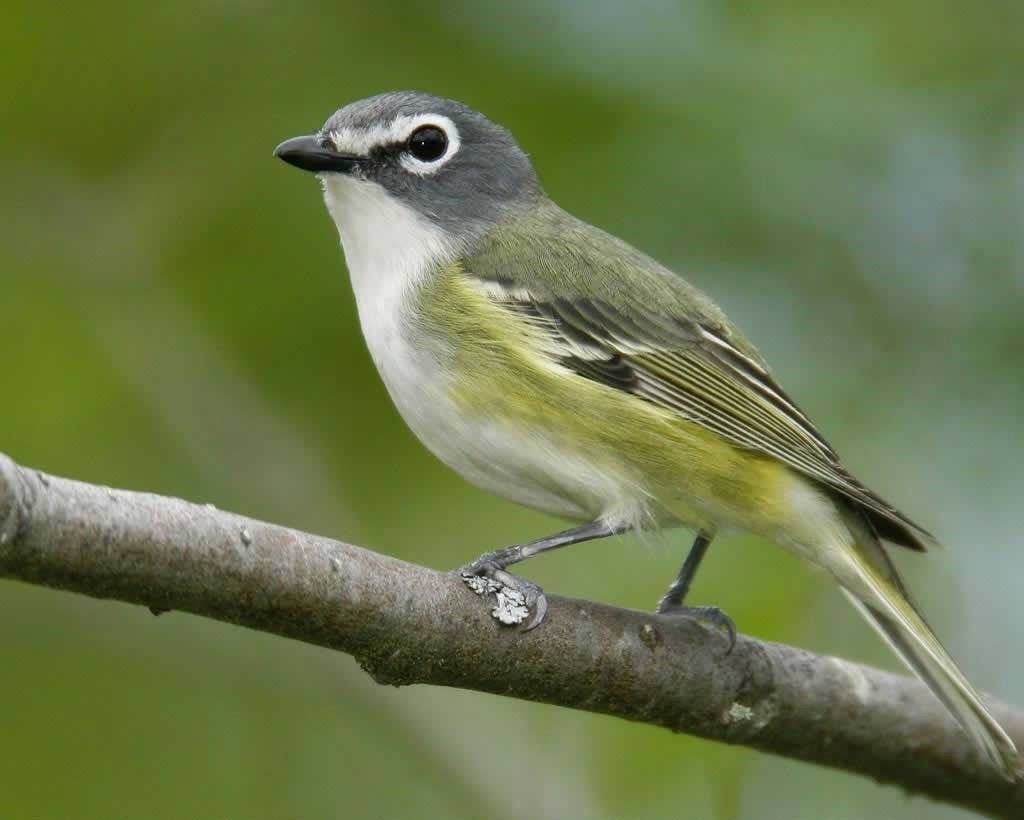
Name: BLUE HEADED VIREO (M)
Scientific name: Vireo solitarius
Name in Spanish: Vireo solitario
Description
This vireo is common in summer in mixed forest, where conifers and deciduous trees grow together. When feeding, it works rather deliberately along branches, searching for insects. Its nest, a bulky cup suspended in the fork of a twig, is often easy to find. This bird was formerly lumped with the western Plumbeous and Cassin’s vireos under the name Solitary Vireo.
Source: https://www.audubon.org/field-guide/bird/blueheaded-vireo
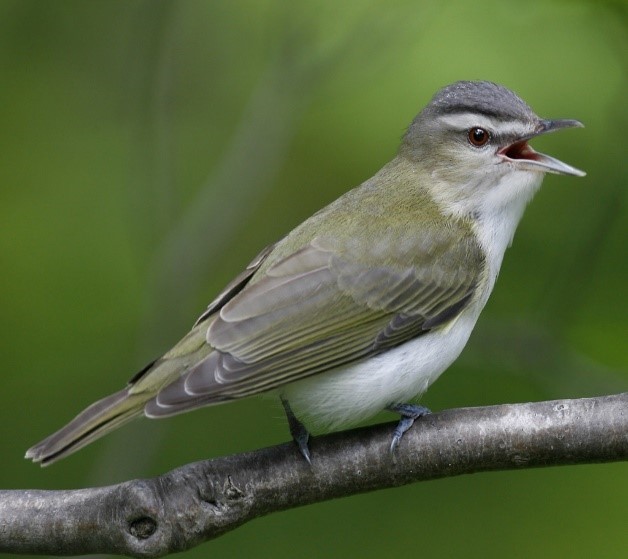
Photo By National Audubon Society www.audubon.org
Name: RED-EYED VIREO (M)
Scientific name: Vireo Olivaceus
Name in Spanish: Vireo de ojos rojos
Description:
One of the most numerous summer birds in eastern woods. It is not the most often seen, because it tends to stay out of sight in the leafy treetops, searching methodically among the foliage for insects.
Migrates mostly at night. Peak migration periods in most areas are May and September. Those breeding in Northwest apparently move east in fall before turning south. *
Source: https://www.audubon.org/field-guide/bird/red-eyed-vireo
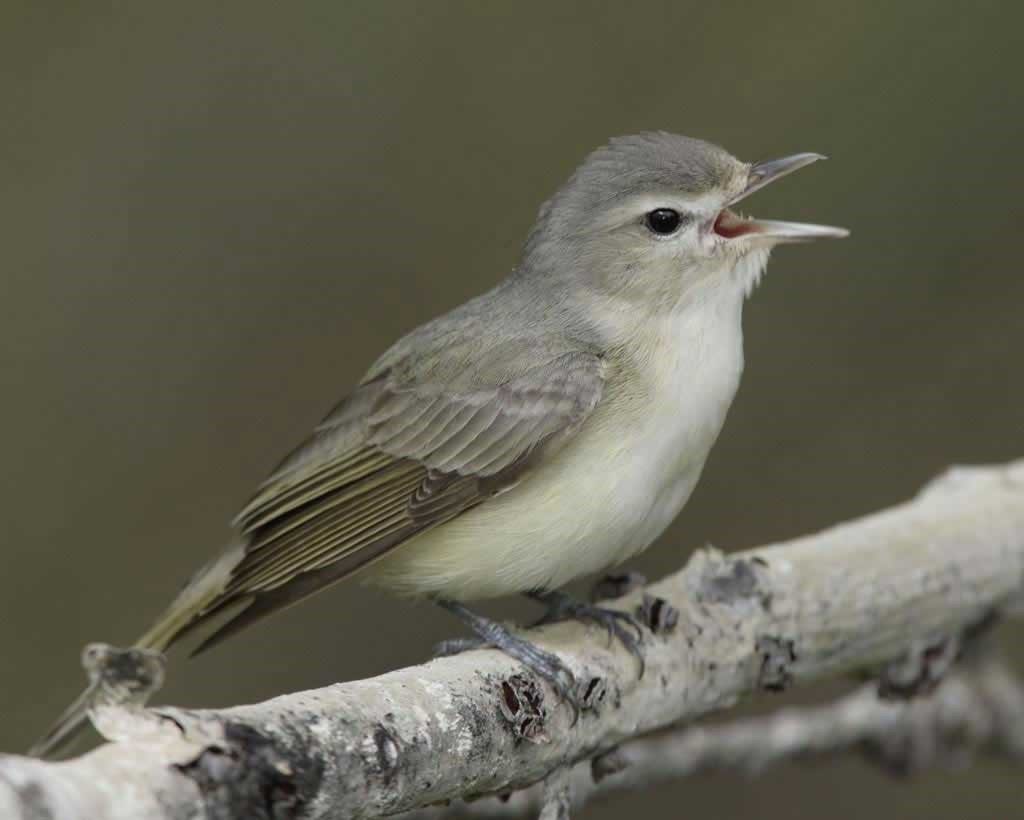
Name: WARLBING VIREO (M)
Scientific name: Vireo Gilvus
Name in Spanish: Chipe vireo o gorgoreador
Description:
The Warbling Vireo is a common summer bird in leafy groves and open woods from coast to coast. Because it avoids solid tracts of mature, unbroken forest, it is probably more common and widespread today than it was when the Pilgrims landed.
Migrates mostly at night. Most eastern breeders apparently travel north and south via Texas and Mexico, rather than flying across Gulf of Mexico. *
*Source: https://www.audubon.org/field-guide/bird/warbling-vireo
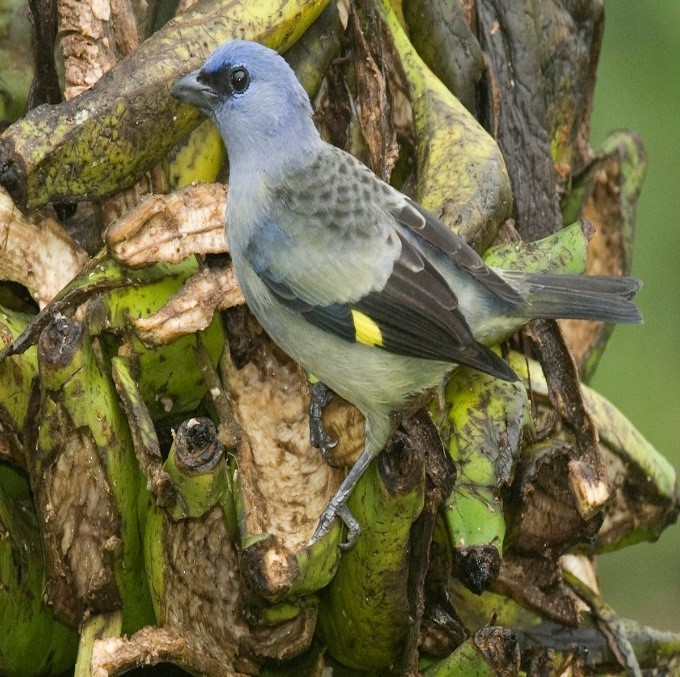
Name: YELLOW-WINGED TANAGER (M)
Scientific name: Thraupis abbas
Name in Spanish: Tángara aliamarilla
Description:
This species and the Blue-gray Tanager (Thraupis episcopus) are the northernmost representatives of the genus Thraupis; both reach well into northeast Mexico, but whereas the Blue-gray Tanager is also widespread in South America, Yellow-winged Tanager reaches its southern terminus in Nicaragua, although there are recent records from northernmost Costa Rica. The species is easily identified by its largely bluish to dusky plumage, relieved principally by the bright yellow blaze at the base of the remiges. Like other Thraupis species, it is usually found at edges and in semi-open areas, and it is rather sociable, being occasionally reported in flocks numbering up to 50 or more individuals. It ranges to at least 1800 m on the Atlantic slope. *
*Yellow-winged Tanager (Thraupis abbas), In Neotropical Birds Online (T. S. Schulenberg, Editor). Cornell Lab of Ornithology, Ithaca, NY, USA. retrieved from Neotropical Birds Online: https://neotropical.birds.cornell.edu/Species-Account/nb/species/yewtan1
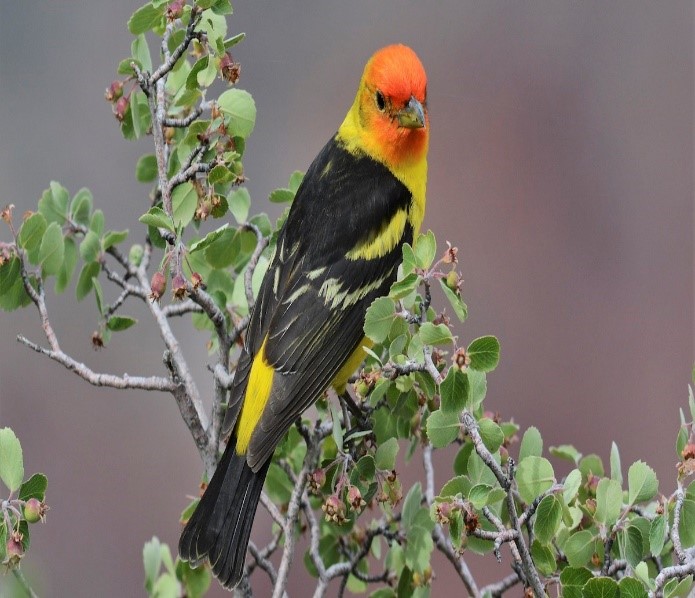
Name: WESTERN TANAGER (M)
Scientific name: Piranga Ludoviciana
Name in Spanish: Tángara aliblanca
A western counterpart to the Scarlet Tanager, this species occurs in summer farther north than any other tanager — far up into northwestern Canada. Western Tanagers nest in coniferous forests of the north and the high mountains, but during migration they may show up in any habitat, including grassland and desert; the bright males often draw attention by pausing in suburban yards in late spring.
Migration: Protracted migration lasts late in spring and begins early in fall, with some birds seen away from breeding areas as late as mid-June and as early as mid-July*
Source: https://www.audubon.org/field-guide/bird/western-tanager
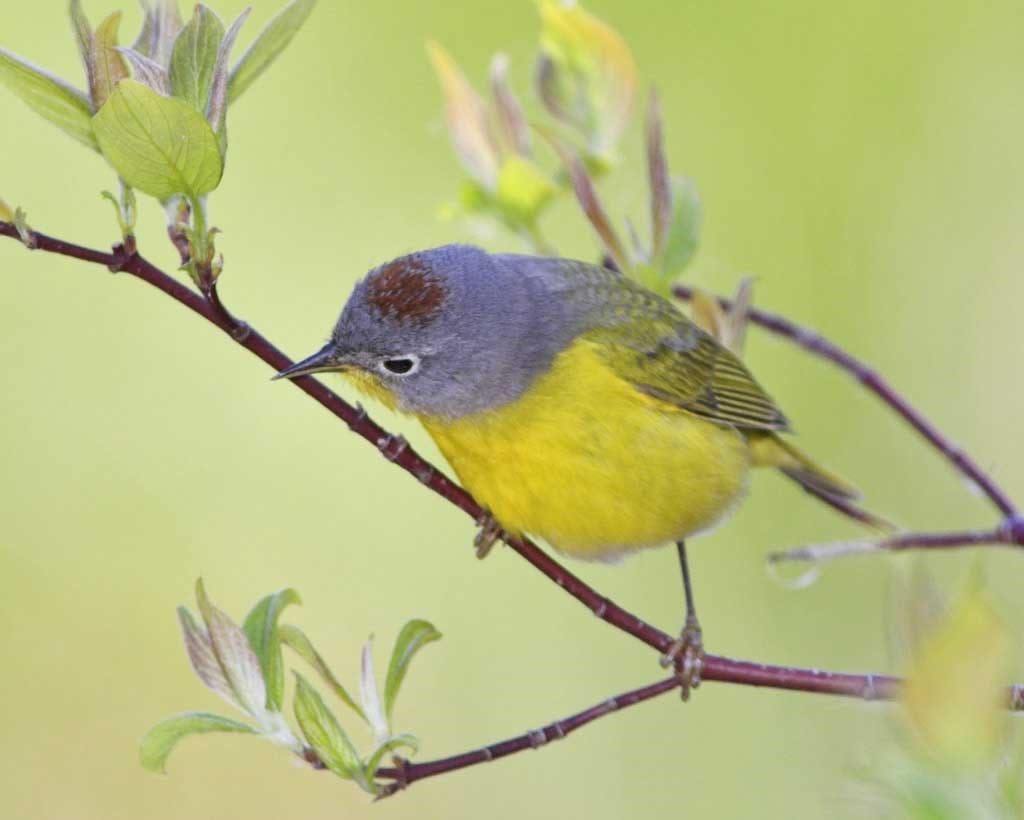
Name: NASVILLE WARBLER (M)
Scientific name: Oreothlypis ruficapilla
Name in Spanish: Reinita o chipe de cabeza gris
Description:
Pioneer birdman Alexander Wilson encountered this bird first near Nashville, Tennessee, and it has been called Nashville Warbler ever since — even though Wilson’s birds were just passing through in migration, and the species does not nest anywhere near Tennessee. This small warbler is common in both the east and the west, often seen foraging in thickets and young trees, flicking its short tail frequently as it seeks insects among the foliage.
Migration
Birds from both eastern and western breeding populations winter mainly in Mexico. Unlike many warblers, does not migrate north across Gulf of Mexico in spring; instead, travels around Gulf, then spreads northeastward to easternmost breeding areas.
Source: https://www.audubon.org/field-guide/bird/nashville-warbler
Name: RUFOUS SABREWING (R)
Scientific name; Campylotepterys Rufus
Name in Spanish: Fandanguero rufo
Rufous Sabrewing is restricted to the highlands of northern Central America where it is most abundant above 1300 meters. It frequents the interior and edge of rainforests, and is also found in plantations, partially wooded canyons, and humid pine-oak forests. These hummingbirds are most active at lower levels, especially in the dense understory and in partially open areas. Both sexes are similar and possess cinnamon colored underparts
*Arizmendi, M. d. C., C. I. Rodríguez-Flores, C. A. Soberanes-González, and T. S. Schulenberg (2013). Rufous Sabrewing (Campylopterus rufus), version 1.0. In Neotropical Birds Online (T. S. Schulenberg, Editor). Cornell Lab of Ornithology, Ithaca, NY, USA. https://doi.org/10.2173/nb.rufsab1.01
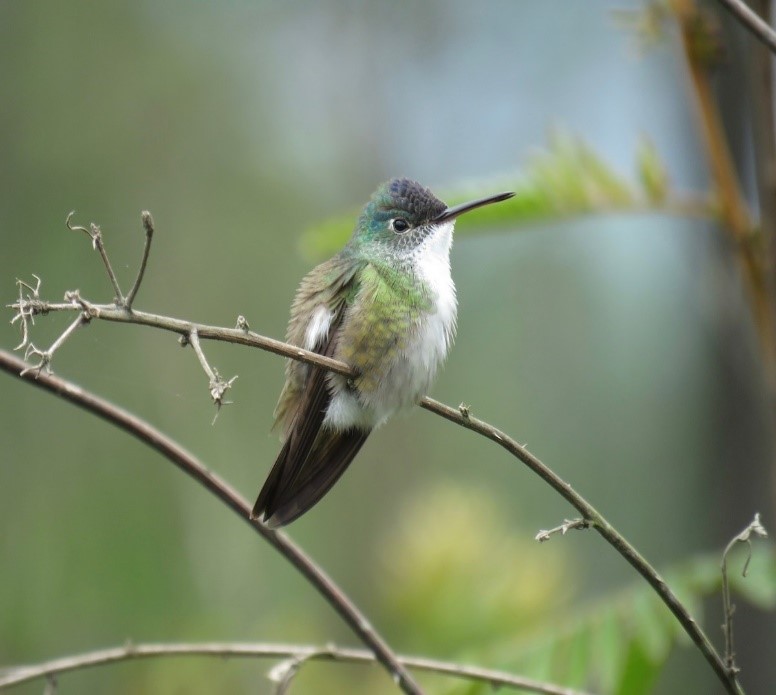
© John van Dort Macaulay Library ML30768081
Name: AZURE-CROWNED HUMMINGBIRD (R)
Scientific name: Amazilia Cyanocephala
Name in Spanish: Colibri coroniazul
Description:
Azure-crowned Hummingbird is a common species throughout many forested habitats from Mexico south to Nicaragua. Even though this hummingbird occupies a wide variety of habitats, in both pine and broadleaf forests from sea level up into the mountains, specific factors limiting the range of the species have not been satisfactorily identified.; generally, this species is blue crowned with a greenish iridescent hindneck, white throat, brownish back and wings, and a thin, red bill with a dark tip. Azure-crowned Hummingbird usually announces its presence with a series of sharp “chup” notes*
*Arizmendi, M. d. C., C. I. Rodríguez-Flores, C. A. Soberanes-González, T. Johnson, and T. S. Schulenberg (2013). Azure-crowned Hummingbird (Amazilia cyanocephala), version 1.0. In Neotropical Birds Online (T. S. Schulenberg, Editor). Cornell Lab of Ornithology, Ithaca, NY, USA. https://doi.org/10.2173/nb.azchum1.01
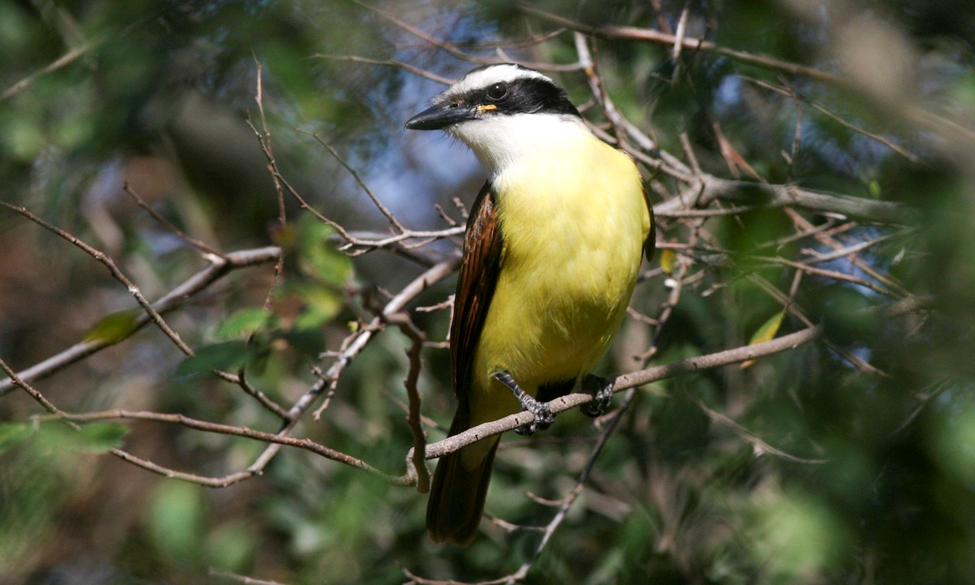
Name: THE GREAT KISKADEE (R)
Scientific name: Pitangus sulpuratus
Name in Spanish: Luis grande
Description:
The Great Kiskadee is a large and strikingly colored flycatcher that inhabits much of Central and South America. It has a black crown with a yellow coronal patch and a broad white supercilium that extends from its forehead to its nape. The kiskadee’s olive-brown wings are set off by cinnamon wing coverts and bright yellow underparts. Great Kiskadees reside in a variety of habitats from forest edges to grasslands to busy residential areas. These birds can often be seen hawking insects from an open perch or dropping to the ground feeding on insects and small reptiles.
*Great Kiskadee (Pitangus sulphuratus), In Neotropical Birds Online (T. S. Schulenberg, Editor). Cornell Lab of Ornithology, Ithaca, NY, USA. retrieved from Neotropical Birds Online: https://neotropical.birds.cornell.edu/Species-Account/nb/species/grekis
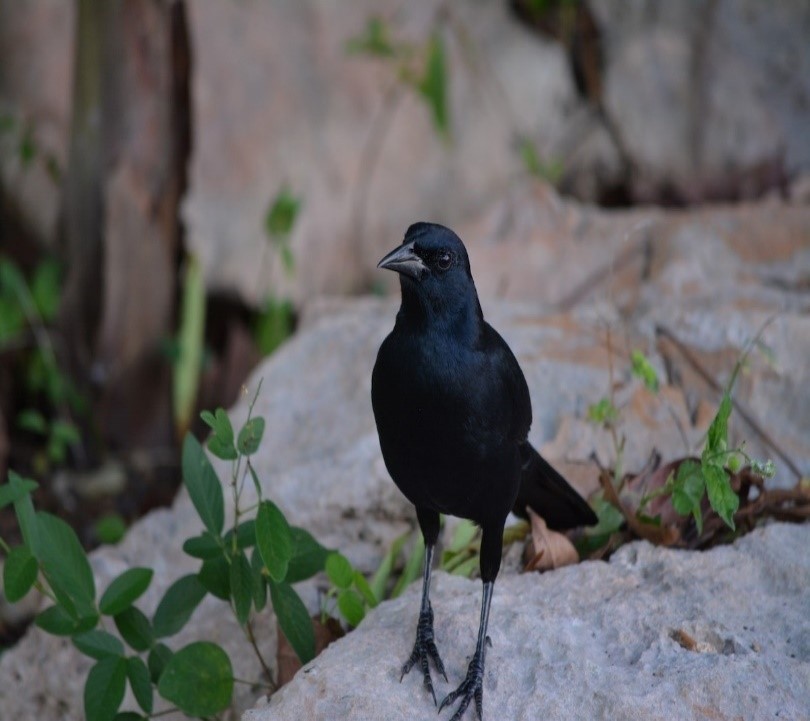
Name: MELODIOUS BLACK BIRD (R)
Scientific name: Dives Dives
Name in Spanish: Zanate Cantor
Description:
The Melodious Blackbird is a rather unique and vociferous all black icterid of Mexico and Central America. It has a relatively thick and long bill, but most noticeable is that the legs and feet look a size too big on this mid-sized blackbird. Pairs appear to be year-round territorial and they likely keep their pair bond for multiple seasons. Melodious Blackbirds pairs perform a unique duetting display where they sing to each other while bobbing up and down as if doing push-ups. The most distinct and easy to recognize note in their song display is a loud “Whit –Tcheeewwww!” that reminds one of a call of a Northern Cardinal (Cardinalis cardinalis), although much louder and more emphatic.
Melodious Blackbird (Dives dives), In Neotropical Birds Online (T. S. Schulenberg, Editor). Cornell Lab of Ornithology, Ithaca, NY, USA. retrieved from Neotropical Birds Online: https://neotropical.birds.cornell.edu/Species-Account/nb/species/melbla1
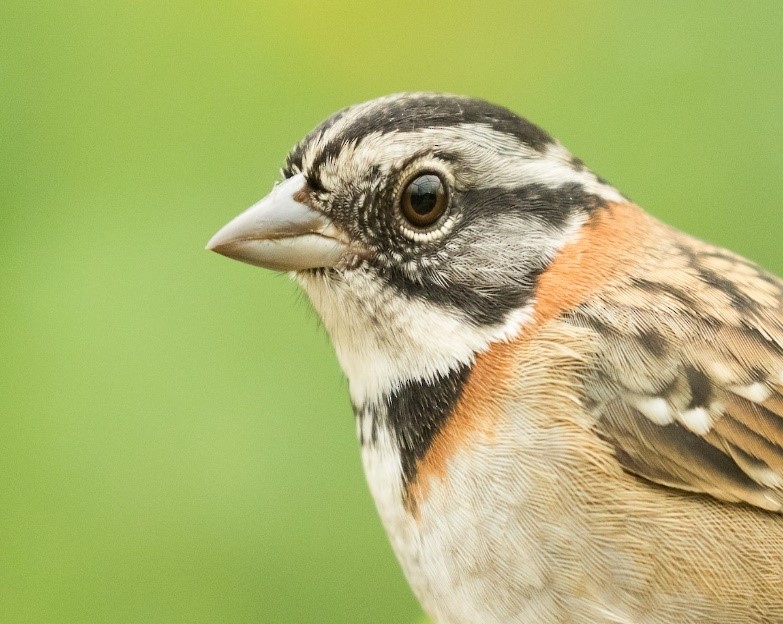
Name: RUFOUS-COLLARED SPARROW (R)
Scientific name: Zonotrichia Capensis
Name in Spanish: Coronadito,
The Rufous-collard Sparrow is a ubiquitous resident of lowland and montane scrub from Mexico south to Tierra del Fuego. Rufous-collared Sparrows have a gray head with two broad black crown stripes and a blackish line through the eye, prominent rufous collar, rufescent upperparts streaked black and white underparts with black patches on either side of the chest. The sparrows are very tolerant to human presence and are a common sight in settlements across South America. Rufous-collard Sparrows are often encountered hopping on open ground as they forage for seeds and insects or singing from a prominent perch on a shrub or rock*
*Rufous-collared Sparrow (Zonotrichia capensis), In Neotropical Birds Online (T. S. Schulenberg, Editor). Cornell Lab of Ornithology, Ithaca, NY, USA. retrieved from Neotropical Birds Online: https://neotropical.birds.cornell.edu/Species-Account/nb/species/rucspa1
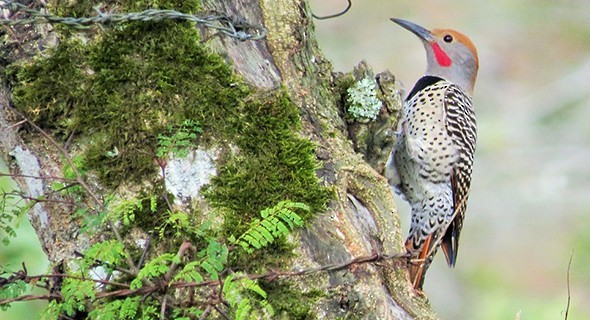
Name: NORTHERN FLICKER (R)
Scientific name. Colaptes auratus
Name in Spanish: Carpintero escapulario
Description:
The Northern Flicker is a common, primarily ground-foraging woodpecker that occurs in most wooded regions of North America. Its taxonomic status has been debated because of hybridization among subspecies groups, each readily distinguished by plumage coloration. Two other subspecies of the Northern Flicker are allopatric; the Cuban Flicker (C. a. chrysocaulosus) occurs on Cuba and Grand Cayman Island, and the Guatemalan Flicker (C. a. mexicanoides) occurs in the highlands of southern Mexico south to northwestern Nicaragua.
Northern Flicker (Colaptes auratus), In Neotropical Birds Online (T. S. Schulenberg, Editor). Cornell Lab of Ornithology, Ithaca, NY, USA. retrieved from Neotropical Birds Online: https://neotropical.birds.cornell.edu/Species-Account/nb/species/norfli
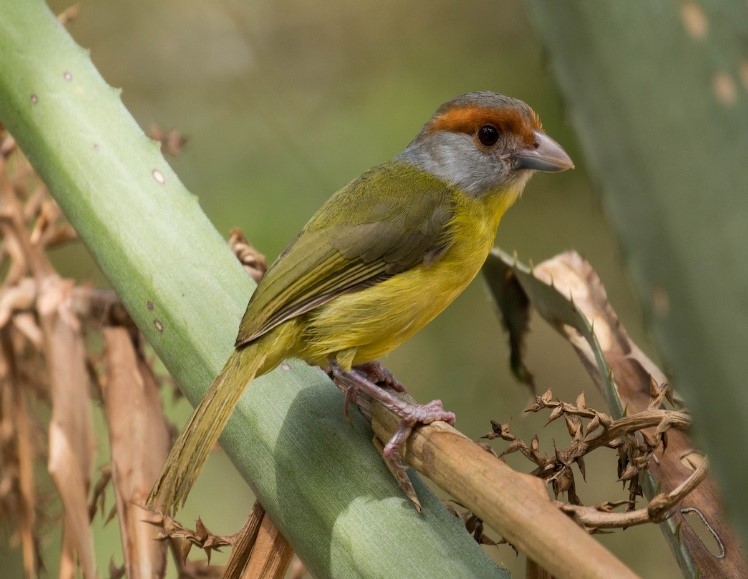
Name: RUFOUS-BROWED PEPPERSHRIKE (R)
Scientific name: Cyclarhis gujanensis
Name in Spanish: Vireo cejirrufo
Description:
The Rufous-browed Peppershrike is one of the largest species of the vireo. It inhabits a wide range of open and semi-open habitats throughout tropical and subtropical Central and South America.
The song is equally as variable but is generally a series of rich musical phrases that is repeated seemingly without end.
Rufous-browed Peppershrike (Cyclarhis gujanensis), In Neotropical Birds Online (T. S. Schulenberg, Editor). Cornell Lab of Ornithology, Ithaca, NY, USA. retrieved from Neotropical Birds Online: https://neotropical.birds.cornell.edu/Species-Account/nb/species/rubpep1
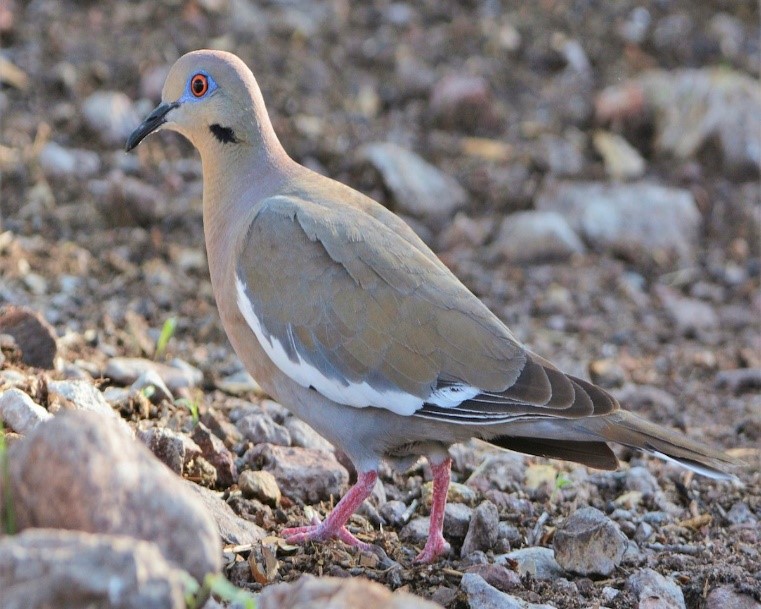
Name: WHITE-WINGED DOVE (R)
Scientific name: Zenaida asiatica
Name in Spanish: Paloma aliblanca
Description:
This large, semitropical dove ranges from the southernmost U.S. and Mexico (where it is partially migratory) south through Central America and much of the West Indies. The majority of White-winged Doves are seasonally migratory. They overwinter in Mexico and Central America and come to the southwestern United States and northern Mexico in April to breed, departing again in September. *
*White-winged Dove (Zenaida asiatica), In Neotropical Birds Online (T. S. Schulenberg, Editor). Cornell Lab of Ornithology, Ithaca, NY, USA. retrieved from Neotropical Birds Online: https://neotropical.birds.cornell.edu/Species-Account/nb/species/whwdov
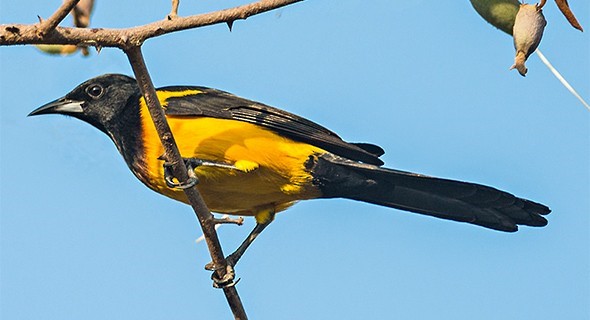
Name: BLACK-VENTED ORIOLE (R)
Scientific name: Icterus wagleri
Name in Spanish: Bolsero de Wagler
Description:
The Black-vented Oriole is widespread in Middle America, between western and central Mexico south to Nicaragua; it inhabits open woodland and scrubby areas, from sea level to 2500 m at least. This species is typically found in pairs, which remain together year-round, and sometimes in small groups, but it is rarely conspicuous*.
*Black-vented Oriole (Icterus wagleri), In Neotropical Birds Online (T. S. Schulenberg, Editor). Cornell Lab of Ornithology, Ithaca, NY, USA. retrieved from Neotropical Birds Online: https://neotropical.birds.cornell.edu/Species-Account/nb/species/bkvori
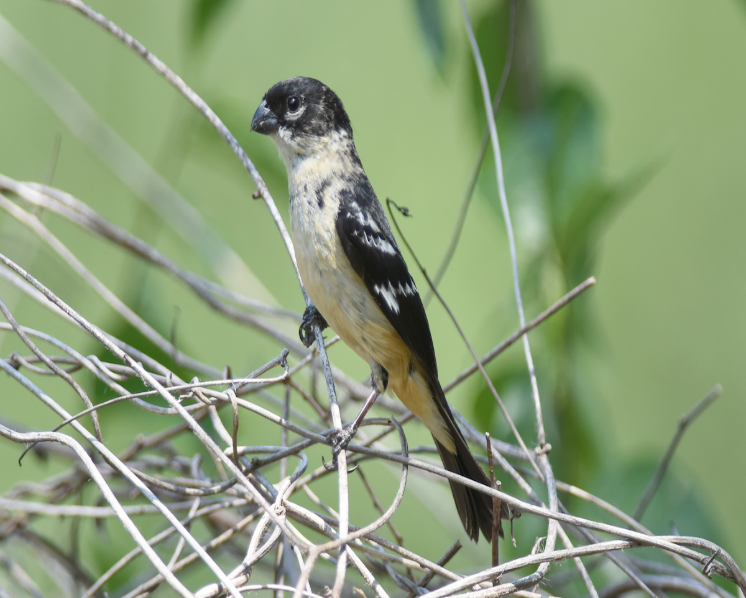
Name: MORELET´S CINNAMON-RUMPED SEEDEATER (R)
Scientific name: Sporophila moreletti/torqueola
Name in Spanish: Semillero collarejo
Description:
The White-collared Seedeater is identifiable by the broad white collar, white rump, and black hood. The species occurs from southern Texas south to the western Panama and is the only member of the widespread genus Sporophila that is confined solely to Mexico and Central America. There are four subspecies of White-collared Seedeater, and the species is split into two species by some authorities. *
*Adel, F., K. J. Burns, J. C. Eitniear, and T. S. Schulenberg (2010). Morelet’s/Cinnamon-rumped Seedeater (Sporophila morelleti/torqueola), version 1.0. In Neotropical Birds Online (T. S. Schulenberg, Editor). Cornell Lab of Ornithology, Ithaca, NY, USA. https://doi.org/10.2173/nb.whcsee.01
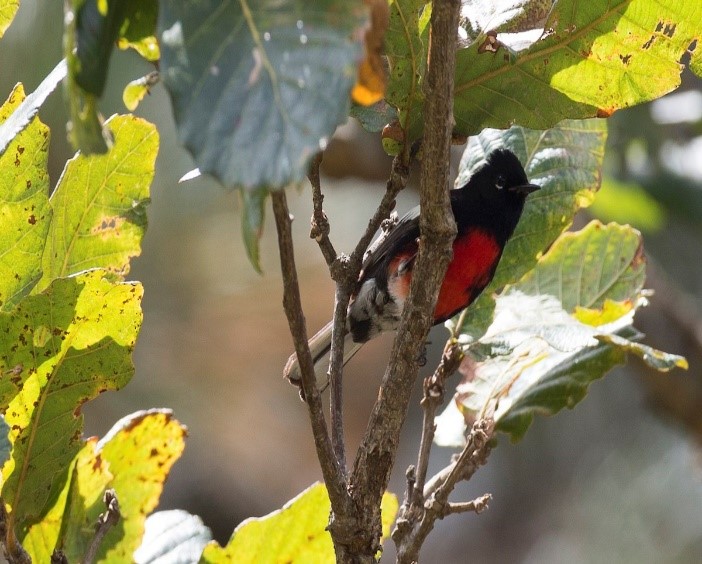
Name: PAINTED REDSTART (R)
Scientific name: Myoborus pictus
Name in Spanish: Pavito aliblanco
Description:
The Painted Redstart is among the most attractive and festive looking of all Parulids. It is largely black, but shows a large white wing patch, extensive white on the outside of the tail, a bright red belly and a surprisingly noticeable white crescent below the eye. It is a bird of Pine-Oak forests found as far north as the Southwest of the United States, south to northernmost Nicaragua. *
*Painted Redstart (Myioborus pictus), In Neotropical Birds Online (T. S. Schulenberg, Editor). Cornell Lab of Ornithology, Ithaca, NY, USA. retrieved from Neotropical Birds Online: https://neotropical.birds.cornell.edu/Species-Account/nb/species/paired
Name: BLUE-AND-WHITE-MOCKINGBIRD (R)
Scientific name: Melanotis hypoleucus
Name in Spanish: Censontle pechiblanco
Description:
A highly distinctive bird within its relatively small range, the strikingly long-tailed Blue-and-white Mockingbird is just that. The entire upperparts are deep blue, except for the black mask, while below the bird is all white, except for the blue gray flanks and vent. *
*Soberanes-González, C. A., C. I. Rodríguez-Flores, M. d. C. Arizmendi, G. M. Kirwan, and T. S. Schulenberg (2013). Blue-and-white Mockingbird (Melanotis hypoleucus), version 1.0. In Neotropical Birds Online (T. S. Schulenberg, Editor). Cornell Lab of Ornithology, Ithaca, NY, USA. https://doi.org/10.2173/nb.bawmoc1.01
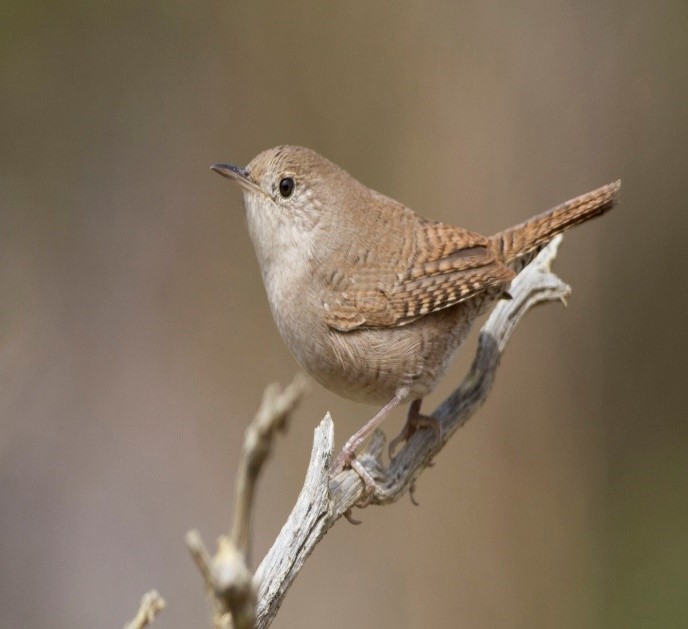
Name: HOUSE WREN (R)
Scientific name: Troglodytes aedon
Name in Spanish: Saltapared sureño
Description:
Looking at the distribution of the House Wren it is easily one of the most widely distributed of all New World songbirds. However, the truth is certainly much more complex. In the past this species has been separated into three groups, with the Isthmus of Tehuantepec in Mexico being a division line between two of these, the southern and northern House Wrens. There has not been a modern genetic study of this species, but surely the reality of how many species level units are in the House Wren complex will be much more complicated. *
*House Wren (Troglodytes aedon), In Neotropical Birds Online (T. S. Schulenberg, Editor). Cornell Lab of Ornithology, Ithaca, NY, USA. retrieved from Neotropical Birds Online: https://neotropical.birds.cornell.edu/Species-Account/nb/species/houwre
Classification:
M= Migrant Birds
R= Resident birds
T= Birds in transit
E= Introduced from Europe
Useful links:
https://www.audubon.org/bird-guide
https://neotropical.birds.cornell.edu/Species-Account/nb/home
http://www.birdwatching.com.gt
25 Stunning And Beautiful Birds You Should Know About!
